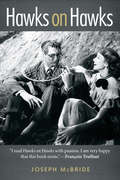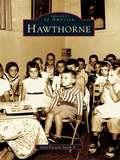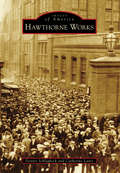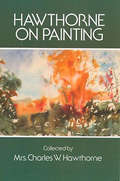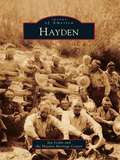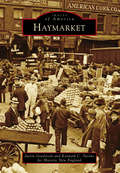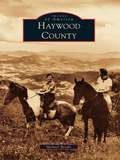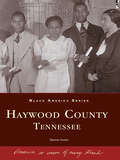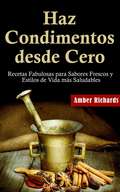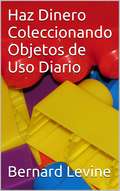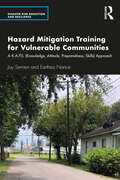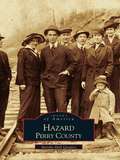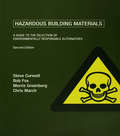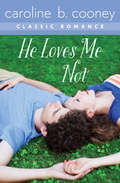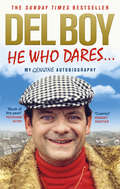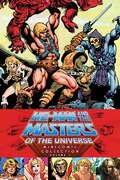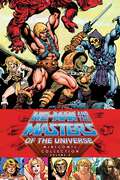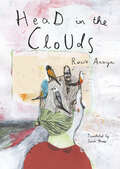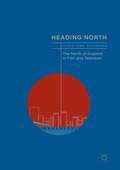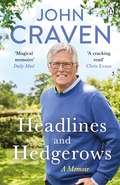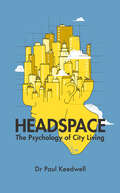- Table View
- List View
Hawks on Hawks (Screen Classics)
by Joseph McBrideA portrait of the renowned film director based on seven years of interviews: “I am very happy that this book exists.” —François TruffautHoward Hawks is often credited as the most versatile of the great American directors, having worked with equal ease in screwball comedies, westerns, gangster movies, musicals, and adventure films. He directed an impressive number of Hollywood’s greatest stars—including Humphrey Bogart, Cary Grant, John Wayne, Lauren Bacall, Rosalind Russell, and Marilyn Monroe—and some of his most celebrated films include Scarface, Bringing Up Baby, The Big Sleep, Red River, Gentlemen Prefer Blondes, and Rio Bravo.Hawks on Hawks draws on interviews that author Joseph McBride conducted with the director over the course of seven years, giving rare insight into Hawks’s artistic philosophy, his relationships with the stars, and his position in an industry that was rapidly changing. In its new edition, this classic book is both an account of the film legend’s life and work and a guidebook on how to make movies.“There are going to be many biographies of Howard Hawks, but they will all lean heavily on this book; the pioneer so honestly reveals himself and the people with whom he worked.” —Los Angeles Times
Hawthorne (Images of America)
by Don Everett Smith Jr.Hawthornne residents can boast of the area's role in the American Revolution remember all who served during wartime, and trace countless families who have lived here for generations. Hawthorne captures the history of this north Jersey borough, home of General Lafayette's local headquarters, whicH today houses the town offices. It echoes old-timers' memories of days spent hiding and playing in Hawthorne's high hills and then running down the steep slopes to the Passaic River for a swim.
Hawthorne Works (Images of America)
by Dennis Schlagheck Catherine LantzA burgeoning town on the fringes of Chicago rose and fell with the successes of the Western Electric Company. For almost 90 years, the Hawthorne Works plant employed, educated, entertained, and defined the township of Cicero. As the manufacturing arm of Western Electric, Hawthorne contributed greatly to the prosperity and national defense of the United States. As the site of the controversial Hawthorne Studies of workplace motivation and behavior, the plant reconfigured business and social science models. A community within a community, Hawthorne had its own sports teams, social clubs, hospital, railroad yards, and savings and loan. At its peak, the works was the largest single-site employer in Illinois and one of the biggest manufacturing establishments in the country, second only to the Ford plant in Detroit. Hawthorne typifies the era when American industrial giants dominated the global economy and generations of blue-collar workers strived for a fair share of the "American Dream."
Hawthorne on Painting (Dover Art Instruction)
by Charles W. HawthorneBorn in 1872, Charles Webster Hawthorne was an American portrait painter who founded the Cape Cod School of Art. This work, collected from notes taken by his actual students at the school, offers hundreds of direct lessons, ideas, suggestions, and more.
Hayden (Images of America)
by Jan Leslie Hayden Heritage CenterThe Hayden area's first settlers, who arrived around 1875, were certain that their hamlet would become the hub of Northwest Colorado. The first regional trading post, Routt County Courthouse, and U.S. post office were established here on the banks of the Yampa River. Nestled in the Yampa's wide, verdant, high-country valley at 6,300 vertical feet, the energetic little town's future was peopled by an assortment of penniless yet hopeful dreamers as well as enterprising ranchers and other businessmen. Ezekiel Shelton brought his family and a myriad of skills. Jim Norvell drifted in on foot and with a few dollars established a mercantile and saloon and later, after "finding religion," a church. While the towns of Craig to the west and Steamboat Springs to the east grew, Hayden retained its familial descendants--"stayers"--enamored of their corner of the beautiful Rocky Mountains and sheltered from most severe weather in the Yampa Valley.
Haymarket
by Kenneth C. Turino Historic New England Justin GoodsteinWith Faneuil Hall opening in 1742, followed by Quincy Market in 1826, Boston's market district was born. Haymarket began as an expansion of Quincy Market in the first half of the 19th century. Over the years, Haymarket has witnessed the Central Artery rise above it in the 1950s and retreat underground almost 60 years later with the completion of the Big Dig in 2007. These obstacles have not stopped the market from serving a constant stream of students and tourists, longtime residents, and newly arrived immigrant families. For most of the 20th century, the pushcarts of Italian produce vendors lined both sides of Blackstone Street. Today's market includes halal butchers, artisanal cheese mongers, and Cambodian fruit sellers. Haymarket is open Fridays and Saturdays from dawn to dusk at the intersections of Hanover, Blackstone, and North Streets and continues to host an ever-changing and diverse population.
Haywood County
by Michael BeadleWith its pristine waterways, abundant forests, and teeming wildlife, Haywood County is referred to as a kind of Eden in Cherokee mythology. All natural water flowing through the county originates within its borders. More than a dozen of its peaks rise above 6,000 feet, including Cold Mountain, made famous by the best-selling Charles Frazier novel. Established in 1808, Haywood County developed into a series of farming communities. Waynesville, the county seat, was the site of the last shot of the Civil War east of the Mississippi River and later grew into a popular tourist destination after rail lines were laid through the county in the early 1880s. On the eastern end, Canton thrived with one of the largest paper mills in the nation, still in operation after more than a century. The county is also home to sections of the Appalachian Trail, Blue Ridge Parkway, and Great Smoky Mountains National Park.
Haywood County, Tennessee (Black America Series)
by Sharon NorrisSurviving slavery, Reconstruction, poverty, and the Civil Rights tensions of the twentieth century, Haywood County's black community has done much to shape the identity of this historic West Tennessee county. This volume, containing over 200 black-and-white images, highlights the county's settlement, the early slave culture, the legacy of its many soulful and talented musicians, such as Anna Mae Bullock (better known as Tina Turner), the hard-fought strides in bringing education to African-American citizens, the importance of church inmolding the social and spiritual elements of life, and some of the county's most recognizable faces and names.
Haz Condimentos Desde Cero Recetas Fabulosas Para Sabores Frescos Y Estilos De Vida Más Saludables
by Amber Richards Mónica SarroHaz Condimentos desde Cero es la mejor guía para más de 300 recetas de comida más sabrosa, alimentos más saludables y grandes ahorros. No utilices condimentos procesados, de baja calidad y caros para tus alimentos. En este libro encontrarás toneladas de recetas maravillosas para tener sabores más frescos y un estilo de vida más saludable. Los resultados son obvios: nuevos niveles de sabores deliciosos para consentir a tu paladar e impulsar tu creatividad sin los efectos dañinos de los condimentos comprados. Trabajas duro en la cocina, ¿por qué conformarte con condimentos que sabotean tu pasión por alimentos saludables?
Haz Dinero Coleccionando Libros, Consigue Autógrafos de Celebridades Gratis, Y Más...
by Azul Lima Alessi Bernard LevinePuedes ganar dinero coleccionando libros, consiguiendo autógrafos de celebridades, vendiendo tus posavasos y hasta puedes ganar dinero coleccionando alambres de púas, ¡y mucho más! ¡Te divertirás coleccionando y generando una gran ganancia!
Haz Dinero Coleccionando Objetos de Uso Diario
by Azul Lima Alessi Bernard LevineEn este divertido y único compendio, descubrirás muchas cosas maravillosas para coleccionar que te obsequiarán con una vida llena de placer, como coleccionar discos de Rock n Roll, juguetes de comida rápida, ositos de peluche, estampillas, monedas, viejas máquinas de escribir, cámaras, juegos de computadora, historietas, plumas para escribir, caracoles, tarjetas de béisbol, mapas, autógrafos, tarjetas postales, latas de cerveza, partituras, cucharitas ¡y mucho más!
Haz Tus Propios Aceites Esenciales De Plantas
by Marcela Gutiérrez Bravo Amber RichardsAprende sobre los beneficios que usar aceites esenciales puede brindarte a tí y a tu familia. Haciendo los tuyos propios de plantas y hierbas accesibles, puedes ahorrar dinero y asegurar que tus aceites son frescos. Descubre recetas únicas y mezclas naturals para diversos problemas de salud,A lo largo de la historia los aceites han y continuarán teniendo roles en el tratamiento de males como:Resfriado y gripe,artritis, insomnio, sistema inmune débil, bronquitis, acné, cortadas, fatiga, problemas digestivos, presión alta y ¡muchos más!
Hazard Mitigation Training for Vulnerable Communities: A K.A.P.S. (Knowledge, Attitude, Preparedness, Skills) Approach (Disaster Risk Reduction and Resilience)
by Joy Semien Earthea NanceThis book is designed to educate vulnerable communities, emergency practitioners, and disaster researchers to increase the social and physical capacity of communities to mitigate and adapt to disaster impacts. With climate change escalating the intensity and range of disasters, we have entered an unprecedented time. The tools in this book allow researchers, practitioners, and community leaders to adopt new training techniques that are more engaging and effective, using a bottom-up framework to integrate knowledge, attitude, preparedness, and skills (K.A.P.S). This book is uniquely designed to support instructors, researchers, practitioners, and community leaders in their effort to promote preparedness across marginalized communities. The book contains a full range of templates, worksheets, survey questions, background information, and guidance for carrying out training; the material has been field-validated to meet research standards. The K.A.P.S. Framework outlined throughout the book is designed to serve as an adaptable model that national and international audiences can utilize to better prepare their communities for disasters due to hurricanes, floods, and tornadoes. As climate change continues to ravage communities, the K.A.P.S. training program will prove to be an important tool for community trainers and academics across a range of hazards and disasters.
Hazard, Perry County
by Martha Hall QuigleyHazard and Perry County have enjoyed a long and colorful history since founder Elijah Combs first settled in the area in 1795. The years have brought a multitude of changes, explored in this engaging visual history. Contained within these pages are vintage photographs depicting the history of an American small town that has always fancied itself a city. Images were culled from the collection at the Bobby Davis Museum, which includes selected photographs from John Kinner, Hal Cooner, L.O. Davis, and others. This work traces the area's development from an isolated mountain village to a center of Eastern Kentucky commerce and culture. Recorded in these images are the devastating floods that often threatened the community, as well as the building of the railroad that brought in everything from automobiles and telephones to Sears and Roebuck prefabricated homes. Aerial shots from the 1940s and 1950s are also included, and accompanying captions document the names and places familiar to oldtimers and intriguing to newcomers in Hazard, Perry County.
Hazardous Building Materials: A Guide to the Selection of Environmentally Responsible Alternatives
by Bob Fox Chris March Steve Curwell Morris GreenbergThis new edition provides a detailed reference source of the use in residential buildings of materials known or suspected to harm health and the environment. Alternative materials are evaluated using unique data sheets which compare environmental impact, cost, health, safety and technical performance providing building and construction professionals and other practitioners with the facts they need to make the right selection.Hazardous Building Materials considers the following building elements: structure, windows and doors, roofing, insulation, finishes and fittings, pipes, services and services equipment. Based on the highly successful format of the first edition this practical reference provides expert advice with the use of clear drawings, tables and data sheets to architects, surveyors, facilities managers, students on built environment courses, material suppliers, environmentalists and clients.
He Loves Me Not: A Cooney Classic Romance
by Caroline B. CooneyA young high school student is so dedicated to her music that she has no time for the romance she secretly craves—until she meets someone who seems to like her just the way she isHe loves me . . .Fifteen-year-old Alison Holland dreams of becoming a professional musician. No sacrifice is too great when it comes to her music—even if it means giving up extracurricular activities like dating and hanging out with friends.Alison is overjoyed when she gets her first professional gig. Soon, she&’s playing at events all over town. But lately, she&’s starting to wonder how it would feel to go to a party as someone&’s girlfriend instead of the keyboard player. She&’s feeling lonely and left out, especially when the night of the big dance arrives—and she doesn&’t have a date.Then, at a wedding, Alison meets Ted Mollison, a photographer. He seems to really get her—to understand her dreams and ambitions. But is he more interested in his camera than in romance?A book for anyone who has ever felt like they&’re different, He Loves Me Not is about fitting in and branching out . . . and being loved for who you are.
He Who Dares
by Derek 'Del TrotterJack-the-lad, wheeler-dealer and international playboy (just ask the manageress of El Sid's, Torremolinos, 1978), this was a man destined for greatness. One day he would mature into an award-winning man of business*, thriving entrepreneur and glittering member of the jet-set. A force of nature, a man who beat the odds, if only for a bit. This is his story. The story of Derek 'Del Boy' Trotter. Who else could tell the glorious tale of rags to riches to rags to rich(ish) but the man himself? You've heard of The Wolf of Wall Street, now meet the Pug of Peckham.*Trotter's Independent Traders, employee of the year 1982 - 2003[He Who Dares has been written by the family of John Sullivan, creator and writer of Only Fools and Horses, who sadly died in 2011. Ebury Press have produced and published the book with full support and involvement of the family.]
He Who Dreams (Orca Limelights)
by Melanie FlorenceJuggling soccer, school, friends and family leaves John with little time for anything else. One day at the local community center, following the sound of drums, he stumbles into an Indigenous dance class. Before he knows what's happening, John finds himself stumbling through beginner classes with a bunch of little girls, skipping soccer practice and letting his other responsibilities slide. When he attends a powwow and witnesses a powerful performance, he realizes that he wants to be a dancer more than anything. But the nearest class for boys is at the Native Cultural Center in the city, and he still hasn't told his family or friends about his new passion. If he wants to dance, he will have to stop hiding. Between the mocking of his teammates and the hostility of the boys in his dance class, John must find a way to balance and embrace both the Irish and Cree sides of his heritage.
He-Man and the Masters of the Universe Minicomic Collection Volume 1
by VariousTHE MOST POWERFUL STORIES IN THE UNIVERSE! The toy juggernaut Masters of the Universe and its subsequent action figure lines featured memorable pack-in minicomics that aided in playtime for children across the world. This two volume digital collection features sixty-eight US releases, including all minicomics from the eighties Masters of the Universe line, the eighties Princess of Power line, and the eighties and nineties He-Man line, plus an introduction to the minicomics in the current Masters of the Universe Classics toy line. Relive the illustrated adventures that fueled your imagination!
He-Man and the Masters of the Universe Minicomic Collection Volume 2
by VariousTHE MOST POWERFUL STORIES IN THE UNIVERSE! The toy juggernaut Masters of the Universe and its subsequent action figure lines featured memorable pack-in minicomics that aided in playtime for children across the world. This two volume digital collection features sixty-eight US releases, including all minicomics from the eighties Masters of the Universe line, the eighties Princess of Power line, and the eighties and nineties He-Man line, plus an introduction to the minicomics in the current Masters of the Universe Classics toy line. Relive the illustrated adventures that fueled your imagination!
Head Cases: Julia Kristeva on Philosophy and Art in Depressed Times (Columbia Themes in Philosophy, Social Criticism, and the Arts)
by Elaine MillerWhile philosophy and psychoanalysis privilege language and conceptual distinctions and mistrust the image, the philosopher and psychoanalyst Julia Kristeva recognizes the power of art and the imagination to unblock important sources of meaning. She also appreciates the process through which creative acts counteract and transform feelings of violence and depression. Reviewing Kristeva's corpus, Elaine P. Miller considers the intellectual's "aesthetic idea" and "thought specular" in their capacity to reshape depressive thought on both the individual and cultural level. She revisits Kristeva's reading of Walter Benjamin with reference to melancholic art and the imagination's allegorical structure; her analysis of Byzantine iconoclasm in relation to Freud's psychoanalytic theory of negation and Hegel's dialectical negativity; her understanding of Proust as an exemplary practitioner of sublimation; her rereading of Kant and Arendt in terms of art as an intentional lingering with foreignness; and her argument that forgiveness is both a philosophical and psychoanalytic method of transcending a "stuck" existence. Focusing on specific artworks that illustrate Kristeva's ideas, from ancient Greek tragedy to early photography, contemporary installation art, and film, Miller positions creative acts as a form of "spiritual inoculation" against the violence of our society and its discouragement of thought and reflection.
Head in the Clouds
by ROCIO ARAYAWith her head in the clouds, Sofía has questions that even her teacher can&’t answer – a joyful and inquisitive book about the vibrant worlds inside our mindsSofía goes to school every day but she still has a lot of questions. Why are grown-ups always in a rush? What number comes after infinity? Sofía&’s teacher says she has her head in the clouds, she&’s seeing birds. In collages of graph paper, worksheets, and newsprint, punctuated by scratches of graphite and bold swaths of bright paint, Sofía&’s world springs to life. When she gives one of her birds to her teacher, her teacher&’s monochrome world of blank paper and gray lines bursts into color, affirming the joy and necessity of always being curious. Inquisitive children, with a supply of questions as limitless as their imagination, will recognize themselves in Sofía, delighting in pondering her questions – and in coming up with more of their own.Originally a painter, Rocío Araya turned to illustration where the field of possibilities, she feels, is infinite. With a style that is spontaneous and full of surprises, her boundless imagination is at work in these exhilarating pages. Look for a tiny, curled, brown cat and an expansive night sky, and spot a hula-girl dancing across a geography worksheet. This treasure hunt of a book is one for reading again and again.
Heading North
by Ewa MazierskaThis collection presents a number of films and television programmes set in the North of England in an investigation of how northern identity imbricates with class, race, gender, rural and urban identities. Heading North considers famous screen images of the North, such as Coronation Street and Kes (1969), but the main purpose is to examine its lesser known facets. From Mitchell and Kenyon's 'Factory Gate' films to recent horror series In the Flesh, the authors analyse how the dominant narrative of the North of England as an 'oppressed region' subordinated to the economically and politically powerful South of England is challenged. The book discusses the relationship between the North of England and the rest of the world and should be of interest to students of British cinema and television, as well as to those broadly interested in its history and culture.
Headlines and Hedgerows: A Memoir
by John CravenTake a trip down memory lane with the memoir from national TV treasure John Craven, as he recounts both the highs and lows of one of the longest entertaining careers in history, and the people and animals that have helped to shape it. _______'A cracking read' Chris Evans, Virgin Radio Breakfast Show_______He began by reading the front page of the evening newspaper in the kitchen to his mother and aunt. Since then he's spoken into microphones to the nation on the BBC almost every week for more than half a century and is one of the most-beloved broadcasters of our time. Presenter of treasured programmes Newsround, Countryfile and Swap Shop, John brought us the headlines and breaking news of our childhood and later helped us discover the magic and wonder of the British countryside. Now, in his first ever autobiography, he recounts a life in news starting with the Grimthorpe Street Gazette, the handwritten newspaper he produced in his early teens - just one copy at a time, so small beginnings. Later, broadcasting on television to millions of children, his casual style of news-reading even found his jumpers making news. He writes about his childhood, his career and the people, events - and animals - that have shaped his life. This is John Craven. And this is the story behind the man so many of us grew up watching on our television screens._______'Magical memoirs. A BBC legend. A broadcasting icon. The best bits from cub reporter to Countryfile . . . his early career sounds like a riot' Daily Mail
Headspace: The Psychology of City Living
by Dr. Paul KeedwellAn examination of the secret psychology of the city and how it affects our daily happiness. More and more of us are choosing to live in the man-made environment of the city. The mismatch between this artificial world and our nature-starved souls can contribute to the stresses of city living in a way that is barely noticed—but is crucially important.What does the science of architectural psychology tell us about how the world of brick and concrete affects how we think, feel and behave?In an increasingly crowded urban world, how does good urban design inspire, restore and bring us together?Conversely, how does bad architecture cause anxiety, alienation and depression?Starting with the home and reaching out to the street, neighbourhood and wider city landscape, Headspace teaches us how to see our cities differently, and how we can best adapt to our rapidly changing urban world.Praise for Headspace“Full of interesting nuggets. Presents the results of scores of scientific studies into the physical environment and does so in a pleasant, discursive way.” —Will Wiles, RIBA Journal“A properly glorious book. Amazing.” —Monocle Radio“Links what we build with what we do. It’s an important question—an architectural holy grail, in a way.” —Evening Standard
